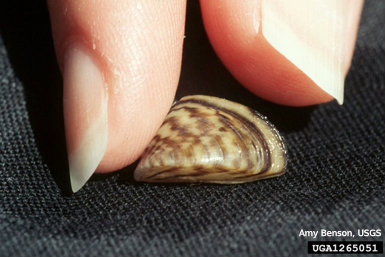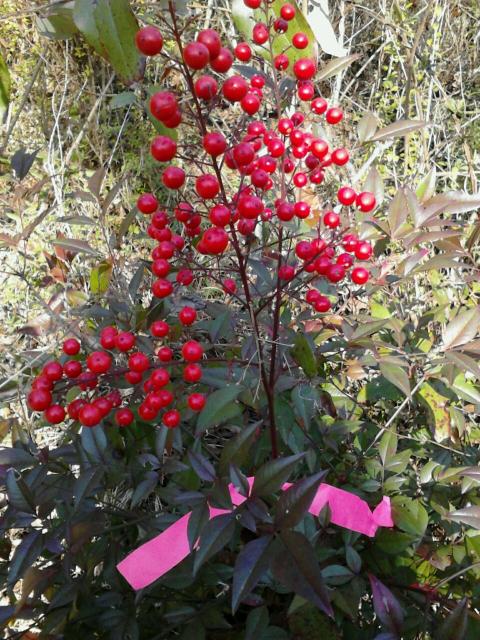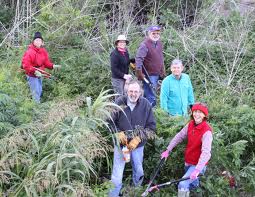 |
 |
|
|
|
|
|
|
|
Zebra Mussels Found in the Trinity River - Below Lake Ray Roberts
The University of North Texas (UNT) recently found Dreissena polymorpha (zebra mussels) colonies in the Trinity River in Denton County. Less than a year has passed since zebra mussels were found in an upstream reservoir, Lake Ray Roberts, and three years since Texas' first zebra mussel discovery in Lake Texoma. Texas Parks and Wildlife, the Lady Bird Johnson Wildflower Center and other partners are working together to stop the spread of zebra mussels by providing outreach materials and allowing Texasinvasives.org visitors to REPORT SIGHTING. |
  |
|
|
|
|
|
|
|
Nandina Toxic to Birds: Cedar Waxwings Found Dead in GA Dozens of Cedar Waxwings were found dead in Thomas County, Georgia in April 2009. More recently, a study was released revealing that several of these birds had evidence of congestion and hemorrhage in various tissues and organs, particularly in the lungs. Cedar waxwings are known to have voracious feeding behavior, and it was found that they had eaten toxic doses of Nandina domestica (nandina or heavenly bamboo) berries. Nandina contains cyanide and is one of the few species to have abundant berries at that time of year in the region. Nandina is a known problematic invasive species, though still often planted as an ornamental. There are many native berry-producing shrub species that can be alternatively planted, and the Georgia Exotic Pest and Plant Council has these suggested alternatives for nandina and other invasive plant species. |
|
 |
|
|
|
|
|
|
|
Legislative News: Improved Lacey Act in the Works Representative Louise Slaughter (D-NY) introduced the Invasive Fish and Wildlife Prevention Act (H.R. 996) on March 6, 2013. The bill updates the Lacey Act to strengthen the U.S. Fish and Wildlife Service's ability to assess and designate a species as "injurious" and improves their ability to limit imports and transports of these species. The bill categorizes injurious species into two levels, and prohibits any person from: (1) Importing or knowingly possessing such an Injurious I or II taxon (2) Engaging in interstate commerce for or knowingly possessing such species (3) Releasing any such species into the wild. The bill also authorizes the Director to immediately and "temporarily" designate a nonnative taxon as Injurious, thus improving the ability to quickly respond to newly introduced problematic species. - Read More. |
|
 |
|
|
|
|
|
|
|
More News Volunteer on National Trails Day: June 1, 2013 Austin Parks Foundation is partnered with Hill Country Conservancy and Texas Conservation Corp [formerly EnvironmentalCorp/AmericanYouthworks] to host Austin's National Trails Day, on Saturday June 1, 2013. - Register Here. Don'tMoveFirewood.org: New E-Newsletter The Firewood Outreach Coordinating Initiative (FOCI) of the Continental Dialogue on Non-native Forest Insects and Diseases is starting an e-newsletter in the hopes of streamlining and facilitating communications with the very wide variety of firewood outreach professionals and stakeholders. - Read April 2013.
Texas A&M Forest Service "Go To Guy" Retires
If you would like your invasive species event or news listed in the next iWire, please send the details to iwire@texasinvasives.org. |
|
|
|
|
|
|
|
|
|
|
|
|
Invasive Plant Removal Efforts:
The Invaders of Texas Program is calling out for a statewide partnership between volunteer groups conducting invasive plant removal work. We want to help you get the tools you need to get the job done! |
|
|
|
|
|
|
|
|
|
Citizen Science Workshops
Invaders of Texas and Sentinel Pest Network Workshops Workshop Schedule:
Saturday June 29th, 2013 For more information or to request a workshop, please visit our Workshop Page. |
|
|
|



